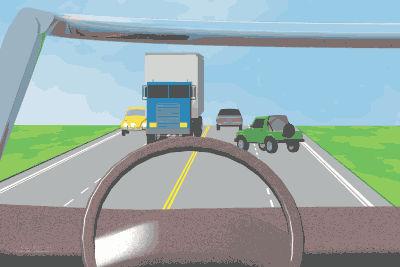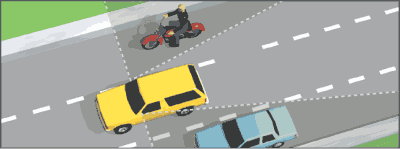Safe driving demands more than just staring out the front window. You should always be looking around and aware of your surroundings. In this guide, we’ll cover some tips and tricks for being aware of your surroundings while driving.
Scanning By Keeping Your Eyes Moving While Driving
Scanning your surroundings (keeping your eyes moving) includes keeping a safe distance around your vehicle. When another driver makes a mistake, you need time to react. Give yourself this time by keeping a “space cushion” on all sides of your vehicle. This space cushion will give you room to brake or maneuver if you need the space.
Looking Far Ahead While Driving
To avoid last minute moves, scan the road 10–15 seconds ahead of your vehicle so you can see hazards early. Constantly staring at the road just in front of your vehicle is dangerous. As you scan ahead, be alert for vehicles around you.
Where is the green vehicle headed?

Use your mirrors. Allow enough space between you and the vehicle ahead to give yourself an “out.” Mistakes cause collisions. In the city, 10–15 seconds is about one block. On the highway, 10–15 seconds is about a quarter of a mile.
Take in the whole scene – If you only look at the middle of the road, you will miss what is happening on the side of the road and behind you
Scanning helps you to see:
- Cars, motorcycles, bicyclists, and people that may be in the road by the time you reach them.
- Signs warning of problems ahead.
- Signs giving you directions.
The shaded areas are your blind spots.

Before changing lanes, look into your rear view mirror for nearby vehicles and also over your shoulder to check for blind spots. Blind spots can hide a motorcyclist, a vehicle or a bicyclist. Watch for things about to happen, like a ball rolling into the street or a vehicle door opening.
Watch for hazards–Look beyond the vehicle ahead of you. Do not develop a “fixed stare.” Keep scanning. Check your rear view mirrors every two – five seconds so you know the position of vehicles near you.
On the freeway, be ready for changes in traffic conditions. Watch for signals from other drivers. Expect merging vehicles at on-ramps and interchanges. Be prepared for rapid changes in road conditions and traffic flow. Know which lanes are clear so you can use them if necessary.
Do not be a tailgater! Many drivers follow too closely (tailgate) and are not able to see as far ahead as they should because the vehicle ahead blocks their view.
The more space you allow between your vehicle and the vehicle ahead, the more time you will have to see a hazard, and stop or avoid that hazard.
Most rear end collisions are caused by tailgating. To avoid tailgating, use the “three-second rule”: when the vehicle ahead of you passes a certain point such as a sign, count “one-thousand-one, one-thousand-two, one-thousand-three.” Counting these numbers takes approximately three seconds. If you pass the same point before you finish counting, you are following too closely.
You should allow a four-second or more cushion when:
- Being crowded by a tailgater. Allow extra room ahead, do not brake suddenly. Slow down gradually or merge into another lane to prevent being hit from behind by the tailgater!
- Driving on slippery roads.
- Following motorcyclists on wet or icy roads, on metal surfaces (e.g., bridge gratings, railroad tracks, etc.), and on gravel. Motorcyclists can fall more easily on these surfaces.
- The driver behind you wants to pass. Allow room in front of your vehicle so the driver will have space to move in front of you.
- Towing a trailer or carrying a heavy load. The extra weight makes it harder to stop.
- Following large vehicles that block your view ahead. The extra space allows you to see around the vehicle.
- You see a bus, school bus, or a placarded vehicle at railroad crossings. These vehicles must stop at railroad crossings; so, slow down early and allow plenty of room.
- Merging onto a freeway.
If you follow too closely and another driver “cuts” in front of you, just take your foot off the gas. This gives you space between your vehicle and the other driver, without having to slam on your brakes or swerve into another lane.
Know What Is At Your Side
Any time you come to a place where people may cross or enter your path or one line of traffic meets another, you should look to the left and right sides of your vehicle to make sure no one is coming. Always look to each side of your vehicle at intersections, crosswalks, and railroad crossings.
At intersections:
- Look both ways even if other traffic has a red light or a stop sign:
- Look to the left first, since vehicles coming from the left are closer to you than vehicles coming from the right.
- Look to the right.
- Take one more look to the left in case there is a vehicle or a pedestrian you did not see the first time.
- Do not rely on traffic signals. Some drivers do not obey traffic signals so before you enter an intersection, look left, right, and ahead for approaching traffic.
To maintain a space cushion on each side of your vehicle:
- Do not stay in another driver’s blind spot. The other driver may not see your vehicle and could change lanes and hit you.
- Avoid driving directly alongside other vehicles on multilane streets with or without traffic in the opposite direction. Another driver might crowd your lane or change lanes without looking and crash into you. Drive either ahead of or behind the other vehicle.
- If possible and when safe, make room for vehicles entering freeways even though you have the right-of-way.
- At freeway exits, do not drive alongside other cars. A driver may decide to exit suddenly or swerve back onto the freeway.
- Keep a space between your vehicle and parked cars. Someone may step out from between them, a vehicle door may open, or a vehicle may pull out suddenly.
- Be careful when driving near motorcyclists or bicyclists. Always leave plenty of room between your vehicle and any motorcyclists or bicyclists.
Know What Is Behind You
It is very important to check behind you before you:
- Change lanes. Look over your shoulder to make sure you are not getting in the way of vehicles in the lane you want to enter.
- Reduce your speed. Take a quick glance in your mirrors. Also check your mirrors when you are preparing to turn into a side road or driveway and when you are stopping to pull into a parking space.
- Drive down a long or steep hill. Watch for large vehicles because they can gather speed very quickly.
- Back up. Backing up is always dangerous because it is hard to see behind your vehicle. When you are backing out of a parking space:
- Check in front and behind the vehicle before you get in.
- Know where your kids are. Make sure they are away from your vehicle and in full view before moving your vehicle.
- If other children are nearby, make sure you can see them before backing up.
- Do not depend only on your mirrors or only looking out a side window.
- Turn and look over your right and left shoulders before you begin backing. As a safety measure, also look over your right and left shoulders again while backing.
- Back slowly to avoid collisions.
Check traffic behind you often to know if you are being tailgated (another driver is following too closely). If you are being tailgated, be careful! Brake slowly before stopping. Tap your brakes lightly a few times to warn the tailgater you are slowing down.
“Lose” the tailgater as soon as you can. Change lanes and allow the tailgater to pass you, or slow down to allow enough “cushion” between you and the car in front of you. If this does not work, pull off the road when it is safe and let the tailgater pass.
Know Your Stopping Distance
If something is in your path, you need to see it in time to stop. Assuming you have good tires, good brakes, and dry pavement:
- At 55 mph, it takes about 400 feet to react and bring the vehicle to a complete stop.
- At 35 mph, it takes about 210 feet to react and bring the vehicle to a complete stop.
Adjust your driving speed to the weather and road conditions (refer to the “Basic Speed Law” in the “Speed Limits” section). Turn on your lights during the day, if it is hard to see or you cannot see at least 1,000 feet ahead of you.
